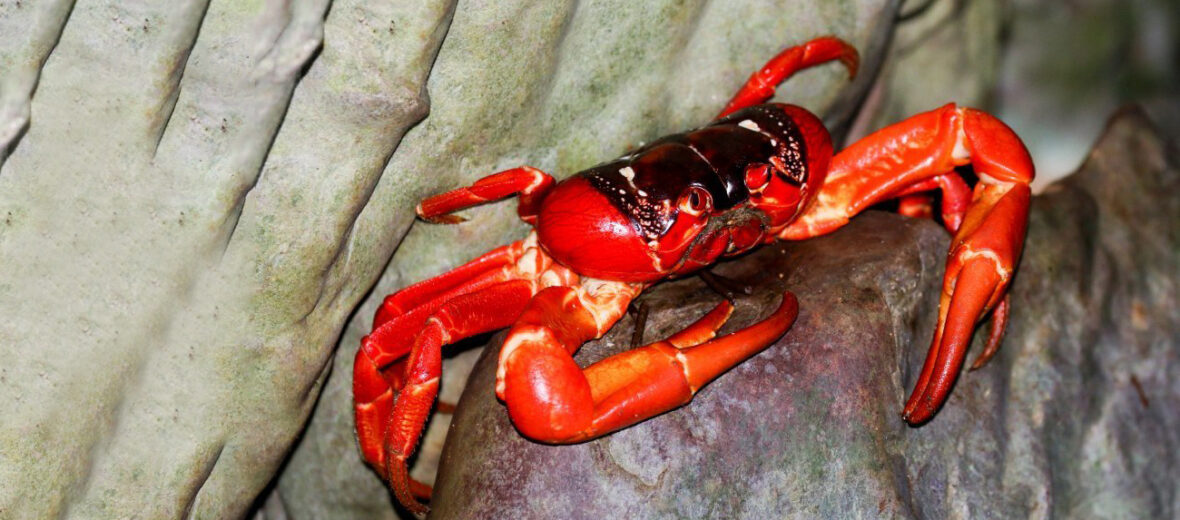
The Christmas Island red crab hails from Christmas Island and the Cocos (Keeling) Islands in the Indian Ocean. Even though these land crabs are under a never-ending assault by yellow crazy ants and vehicle strike (being hit by vehicles), these crabs are abundant and not listed by the IUCN. There are an estimated 30+ million individuals on these islands!
First the Stats…
Scientific name: Gecarcoidea natalis
Weight: Up to 17 ounces
Length: Up to 4.6 inches
Lifespan: Up to 12 years
Now on to the Facts!
1.) In recent years, the yellow crazy ants, which were accidentally introduced, have killed upwards of 15 million of these crabs.
2.) While typically red, they can also be orange or even purple.
3.) Even though these crabs live on land, they need to keep their gills moist in order to breathe, so they need access to water.
4.) These crabs are almost completely nocturnal (active at night).
5.) They will dig burrows to shelter themselves from the hot sun and use the burrows year after year.
But wait, there’s more on the Christmas Island red crab!
6.) During the dry season, they will remain in their burrows for up to 3 months and emerge during the start of the wet season.
7.) Sans their mass migration each year, these crabs are solitary and territorial, defending their burrow from any intruders.
Did you know…?
If a claw or limb becomes injured or removed, a new limb or claw will regenerate.
8.) Besides becoming active during the wet season, their migration is also correlated to the cycle of the moon.
9.) During their migration, red crabs leave their burrows and make their way to the coast to mate and spawn. This typically takes about 1 week, with the male crabs usually showing up before the females. Once on the shore, the male crabs dig burrows, that they defend from other males.
10.) The mating process occurs close to or in the burrows. Not long after mating the males return to the forest while the females stay in the burrow for another 2 weeks.
But wait, there’s still more on the Christmas Island red crab!
11.) During their stay in the burrow, the female will lay her eggs and incubate them in her abdominal brood pouch to aid in their development.
12.) Once the incubation is complete, the females leave their burrows and release their eggs into the ocean, exactly at the turn of the high tide during the last quarter of the moon.
Did you know…?
The juvenile crabs, measuring only .20 inch across, make a harrowing 9-day journey to the center of the island. Once there they will stay mostly hidden for 3 years, under leaf litter, rocks, and fallen trees.
13.) The eggs hatch as soon as they touch sea water.
14.) Once the eggs are deposited into the ocean, the females return to the forest. The eggs hatch and the crab larvae spend up to an additional 4 weeks at sea before returning to land as juvenile crabs.
15.) During their time at sea, the larvae go through several larval stages, ultimately developing into shrimp-like animals called megalopae.
But wait, there’s still a little more on the Christmas Island red crab!
16.) These crabs are opportunistic, omnivorous scavengers, and cannibals. They eat fallen fruits, leaves, flowers, and seedlings. However, they will also feast on carrion (dead animals), each other, and will gladly partake in trash left behind by humans.
17.) The giant African land snail is also another favorite food choice for these crabs.
18.) During their larval stage, millions of red crab larvae are consumed by fish and large filter-feeders like whale sharks and manta rays that visit Christmas Island specifically during the red crab breeding season.
19.) Coconut crabs also prey on juvenile and adult red crabs.
20.) The large population of these crabs is, in part, due to the extinction of the endemic Maclear’s rat in 1903, which may have fed on these crabs.
Now a Short Christmas Island Red Crab Video!
Be sure to share & comment below! Also, check out the Critter Science YouTube channel. Videos added regularly!
Want to suggest a critter for me to write about? Let me know here.
Some source material acquired from: Wikipedia
Photo credit: iNaturalist



